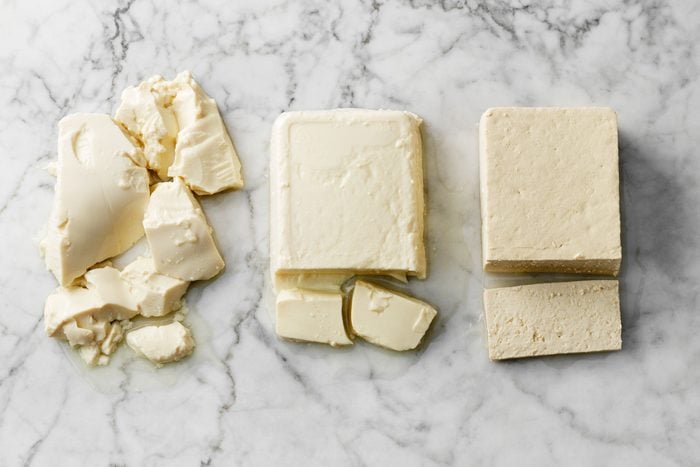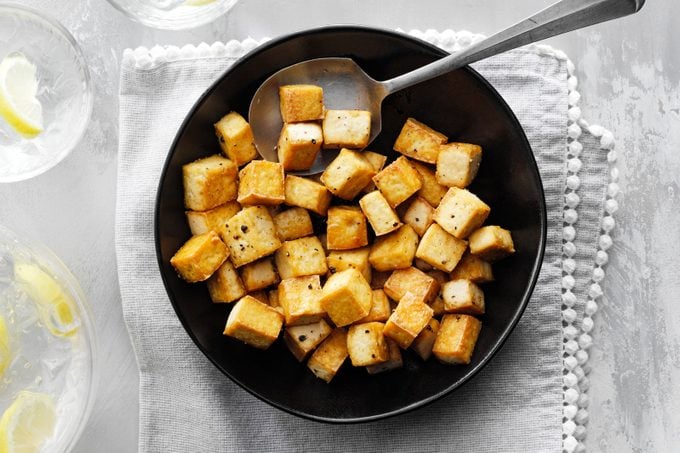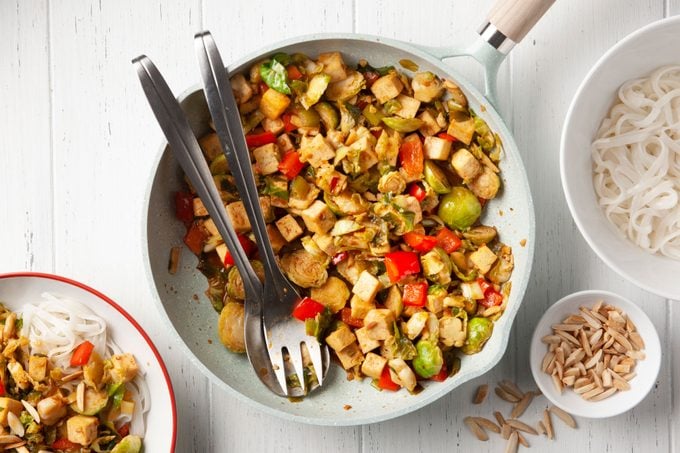What Is Tofu?
Updated: Nov. 09, 2023

We've all heard of it, but what exactly is tofu? Read on to learn what this high-protein meat substitute is made of and how to cook it.
Whether you’re a new vegetarian or interested in eating less meat, say hello to tofu! This versatile, easy-to-use ingredient is a plant-based meat substitute that’s a great source of protein. But what is tofu, exactly? Here’s everything you need to know.
On This Page
What Is Tofu?
Tofu, also known as bean curd, is a plant-based protein made from soy. To make tofu, dried soybeans are soaked until tender, then crushed and boiled. The result is soy milk. Coagulents are added to separate the soy milk into curds and whey (similar to cheesemaking, minus the dairy). Firm tofu is made mainly from curds, while silken tofu contains both curds and whey.
Compared to other soy-based meat replacements, like tempeh, tofu is very smooth. It has a soft texture with a slight chew and mild flavor, making it a versatile addition to many dishes. In many ways, tofu is like chicken, game to absorb whatever flavor stars in your marinade or sauce.
Types of Tofu
Silken tofu
Silken tofu is also known as soft tofu. As it sounds, silken tofu is extremely soft, almost pudding-like in its texture. It doesn’t hold together well, and is often used to thicken or enrich desserts, smoothies, soups and dressings. Silken tofu is sold in soft, medium and firm. The first two are generally interchangeable and best in creamy recipes. Firm silken tofu is often cubed and stirred into miso soup.
Firm tofu
Firm tofu, also known as Chinese-style tofu, has less moisture than silken tofu. Its buoyant, springy texture is easy to slice or cube, and firm tofu can hold up to cooking methods like sauteing and stir-frying. Firm tofu is a good choice for marinating as it will absorb flavor nicely and cook well.
Extra-firm tofu
Extra-firm tofu is similar to firm, only with less moisture and a firmer, almost meaty texture. Extra-firm tofu is best for frying and sauteing. In general, firm and extra-firm varieties are interchangeable.
Firmer types of tofu can be cut into cubes or crumbled like cheese. You can saute tofu plain to achieve a crisp browned exterior, or marinate tofu to infuse it with flavor.
Is Tofu Good for You?

Generally speaking, yes. Tofu is a nutrient-rich staple in diets around the world. It’s a great source of protein, fiber, iron and calcium, as well as being low in fat and cholesterol-free. It’s thought that tofu can also help protect against certain cancers and benefit your heart.
But soy doesn’t have the greatest reputation—no matter how it’s being consumed. While there is no solid conclusion regarding the health drawbacks of soy or GMOs, we suggest opting for organic, non-GMO tofu whenever possible and chatting with your doctor or a nutritionist if you’re concerned.
Tofu Nutritional Breakdown
According to our sister site The Healthy, a single serving of tofu (1.2 cups) contains:
Calories: 94
Total fat: 5.9 g
Saturated fat: 0.9 g
Cholesterol: 0 mg
Carbohydrate: 2.3 g
Dietary fiber: 0.4
Protein: 10 g
Sodium: 8.7 mg
How to Cook with Tofu
Think of tofu as a sponge. It’s a blank canvas that soaks up sauces and spices, making it extremely versatile. When learning how to cook tofu, it’s crucial to remember that different types of tofu are cooked differently.
Tofu is generally packed in water to preserve its freshness, but the soft soy can soak up a lot of excess moisture. For silken tofu, that’s not generally an issue. But if you cook medium or firm tofu straight from the package, it will remain stubbornly soggy and pale, and won’t absorb as much flavor. Luckily, there’s a simple trick to expel excess water and ensure tofu browns well: Press the tofu. Skipping this step is a common mistake when cooking tofu, and it may make the difference between enjoying tofu and disliking it.
To press tofu, remove it from the package and put it on a cutting board lined with a paper towel. Top with another paper towel and then another cutting board or flat, sturdy surface. Set a heavy cast-iron pot or a few thick cookbooks on top. The weight will help squeeze liquid from the tofu. Leave it for about 15 or 20 minutes. Discard the wet paper towels and drain any excess water. The tofu is now ready to use in your recipe.
Tofu Recipes to Try at Home

Our most popular tofu recipes showcase the flexibility of this ingredient:
- Pair tofu with fresh veggies in a tasty Brussels sprouts stir-fry.
- Substitute tofu for chicken in these spicy Buffalo tofu wraps.
- Craving comfort food? You can’t go wrong with a tofu and vegetable potpie.
- Put silken tofu to work in this creamy mushroom soup.
- Sneak secret ingredient tofu into banana nut bread.
- Try an easy “better than egg” salad for lunch.
- Cube tofu and stir it into any curry recipe.
Where to Buy Tofu
You can pick up tofu along with your other plant-based groceries. Tofu can be found at specialty stores, like local co-ops and vegan shops, but it should be readily available at your supermarket, too. Tofu is often shelved in the produce section or in a natural foods section of the store. It’s typically refrigerated, but there are a few shelf-stable varieties as well.
When buying tofu, check that the package is heavy. Refrigerated tofu is stored in water, so if your container feels light, it’s likely been damaged during transport. Then check the date to ensure your tofu is fresh.
Here are some of our favorite brands to look for:
- Nasoya: A go-to name brand, Nasoya tofu is both organic and verified non-GMO.
- Trader Joe’s: Your local TJ’s carries a wide variety of tofu, including organic and high protein.
- Simple Soyman: Handmade in Milwaukee, you can rest easy knowing this brand’s tofu is, well, simple.
For the best (and often freshest) selection, check out an Asian market near you.





















